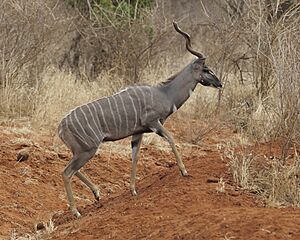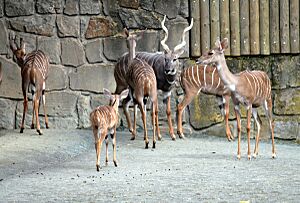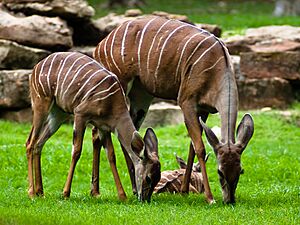Lesser kudu facts for kids
Quick facts for kids Lesser kudu |
|
|---|---|
 |
|
| Adult male | |
| Conservation status | |
| Scientific classification | |
 |
|
| Range map | |
| Synonyms | |
|
The lesser kudu (Tragelaphus imberbis) is a medium-sized antelope found in East Africa. It lives in bushland areas. This animal is part of the Tragelaphus family, which includes other striped, spiral-horned antelopes. Some relatives are the greater kudu, the bongo, and the nyala. An English zoologist named Edward Blyth first described the lesser kudu in 1869.
Lesser kudus are about 110–140 cm (43–55 in) long from nose to tail. Males are taller, reaching 95–105 cm (37–41 in) at the shoulder. Females are a bit smaller, around 90–100 cm (35–39 in) tall. Males weigh more, typically 92–108 kg (203–238 lb). Females weigh 56–70 kg (123–154 lb).
Only male lesser kudus have horns. These spiral horns are 50–70 cm (20–28 in) long. They have about two to two-and-a-half complete twists. Lesser kudus have very special markings. Females and young ones have a golden-brown coat with white stripes. Males turn dark grey after about two years. They also grow shaggy hair down their backs.
Both males and females have unique white markings. These include white lips and spots on their cheeks. They also have white patches on their throats and chests. These markings help them hide in bushes. They might also help keep certain body parts cool.
Lesser kudus eat only plants, mainly leaves from tall bushes and trees. They are most active from dusk until dawn. During the day, they hide in thick bushes. Lesser kudus do not fight over territory. Females often live in groups, but adult males prefer to be alone. They can give birth at any time of the year.
The lesser kudu lives in dry bushland and scrubland. You can find them in Ethiopia, Kenya, Somalia, South Sudan, Tanzania, and Uganda. They might have lived in Saudi Arabia and Yemen in the past. The total number of lesser kudus is about 118,000. Their numbers are going down. The International Union for Conservation of Nature says they are "near threatened".
Contents
About the Lesser Kudu
The scientific name for the lesser kudu is Tragelaphus imberbis. It belongs to the Bovidae family, which includes cattle and goats. Edward Blyth first described this animal in 1869. The name Tragelaphus comes from Greek words. Tragos means "male goat," and elaphos means "deer." The word imberbis is Latin for "unbearded." This refers to the kudu's lack of a mane.
The name "kudu" might come from the Khoikhoi language or the Afrikaans word koedoe. The word "lesser" means this antelope is smaller. It is not as big as the greater kudu.
Scientists have studied the lesser kudu's genes. They found that it is a very old branch of its family tree. This means it split off from other related animals a long time ago.
Physical Features
The lesser kudu is an antelope with spiral horns. Its body length is usually between 110 and 140 cm (43 and 55 in). Males are taller, reaching about 95–105 cm (37–41 in) at the shoulder. Females are a bit shorter, around 90–100 cm (35–39 in) tall. Males typically weigh 92–108 kg (203–238 lb). Females weigh 56–70 kg (123–154 lb). Their bushy tail is 25–40 cm (9.8–15.7 in) long. It is white underneath and has a black tip.
Males and females look different. This is called sexual dimorphism. Males are much larger than females. Females and young kudus have a reddish-brown coat. Males become yellowish-grey or darker after they are two years old. Males also have a black crest of hair on their neck.
A long white stripe runs along their back. There are 11 to 14 white stripes branching out to their sides. They have a black stripe from each eye to the nose. A white stripe goes from each eye to the center of their face. The area around their lips is white. Their throat has white patches. They also have two white spots on each side of their lower jaw. Their underparts are completely white. Their slender legs are tan with black and white patches. Lesser kudus have large, rounded ears. They usually live for 10 years in the wild. In zoos, they can live up to 15 years.
Only males have horns. These spiral horns are 50–70 cm (20–28 in) long. They have two to two-and-a-half twists. The horns are dark brown with white tips. Young males start growing horns after 6 to 8 months. Their horns reach full length after 3 years.
Life and Habits
Lesser kudus are mostly active at night and during dawn. They hide in thick bushes after sunrise. They can camouflage so well that you might only see their ears or tail. They spend the middle of the day resting in shaded areas. Lesser kudus are shy and careful animals.
When they sense danger, they stand very still. If a predator gets close, they make a short, sharp bark. This sound is like a bushbuck's bark. Then, they leap up to 2 m (6.6 ft) high with their tail raised. If caught by a predator, they let out a loud bleat.
Lesser kudus are social animals, especially females. There is no clear leader in their groups. They do not fight over territory, so fights are rare. Females can stay together for several years. A group might have one to three females and their young. Young males leave their mothers at about 18 months old. They might form pairs with other young males. However, males usually prefer to live alone when they are 4 to 5 years old. They usually avoid other males. Lesser kudus do not often mix with other animal species.
Diet
The lesser kudu is a browser. This means it eats leaves from bushes and trees. It also eats fresh shoots, twigs, and herbs. If available, they will eat flowers and fruits. They eat small amounts of grass, mostly when it's wet. Leaves from trees and bushes make up most of their diet all year.
They mainly eat at dusk, dawn, or at night. Lesser kudus do not need much water. They can get enough moisture from succulent plants. These include wild sisal and Sansevieria (snake-plants). They will drink water if it is available.
Reproduction and Life Cycle
Both male and female lesser kudus can have babies when they are about 18 months old. However, males usually start mating after they are four or five years old. They can have babies until they are about 14 years old. Females can have babies and feed them until they are 13 to 18 years old. There is no special breeding season. Babies can be born at any time of the year.
The mother carries the baby for 7 to 8 months. Only one calf is born at a time. A female about to give birth will leave her group. She stays alone for a few days after the birth. A newborn calf weighs 4–7.5 kg (8.8–16.5 lb). About half of the calves die within their first six months. Only about 25% survive past three years old.
The mother hides her calf while she goes to find food. She comes back mainly in the evening to feed her young. She checks her calf by sniffing its rump or neck. The mother and calf talk to each other with soft bleats.
Where They Live
The lesser kudu lives in dry bushland areas. They like places with Acacia and Commiphora thorn bushes in dry parts of northeastern Africa. They avoid open areas and long grass. They prefer shaded areas with short grasses. You can also find them in woodlands and hilly areas. They usually live below 1,200 m (3,900 ft) in height. However, they have been seen higher, near Mount Kilimanjaro.
The lesser kudu is native to Ethiopia, Kenya, Somalia, South Sudan, Tanzania, and Uganda. They are no longer found in Djibouti. Today, they are mostly found in the Horn of Africa. In the past, they lived in southern and eastern Ethiopia, most of Somalia, and Kenya. They also lived in parts of Sudan, Uganda, and Tanzania. There is some evidence they might have lived in the Arabian peninsula too.
Threats and Conservation
The lesser kudu is shy and good at hiding. This has helped protect it from hunting. For example, in the Ogaden region, they are common despite hunting. However, diseases like rinderpest have caused their numbers to drop. In Tsavo National Park in Kenya, their population fell by 60% due to this disease. Other threats include too much grazing by other animals, human settlements, and losing their habitat.
The total number of lesser kudus is about 118,000. This number is going down. The population has dropped by 20% in the last two decades. Because of this, the IUCN now lists the lesser kudu as "near threatened". About one-third of the lesser kudu population lives in protected areas. These include Awash, Omo, and Mago National Parks in Ethiopia. They also live in Lag Badana National Park in Somalia and Tsavo National Park in Kenya. They are also found in Ruaha National Park in Tanzania. However, more lesser kudus live outside these protected areas.
The handsome head of the male lesser kudu, with its elegant spiraled horns, is the symbol of the Saint Louis Zoo.





